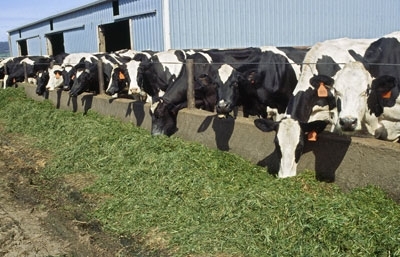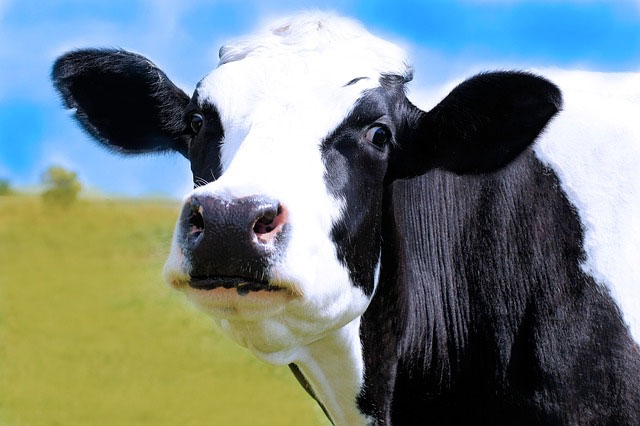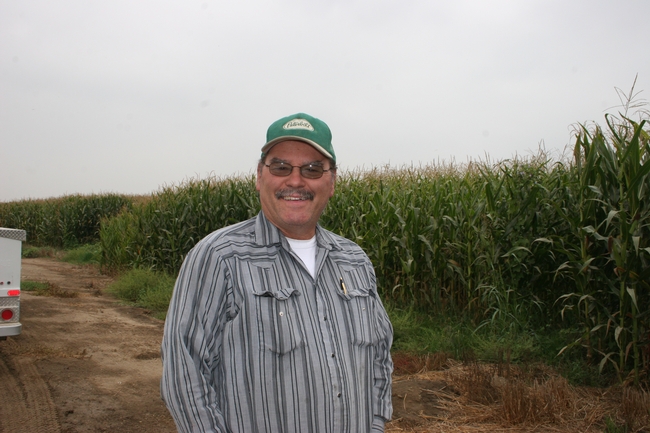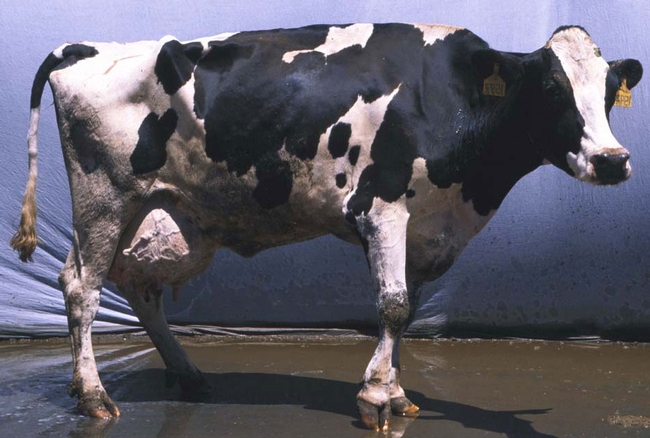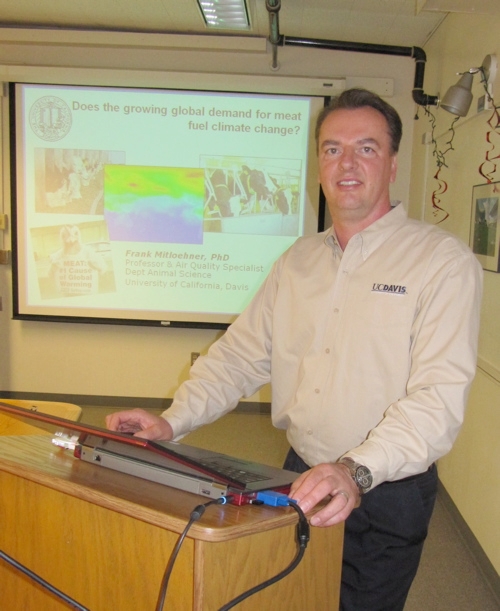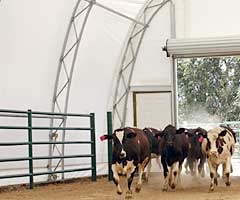Posts Tagged: dairy
UC ANR clarifies drought misconceptions
In two recent broadcast media stories, UC Agriculture and Natural Resources experts were able to provide accurate information about the water use on commodities that have been criticized for water consumption during the drought.
The director of UC ANR's Agricultural Issues Center, Daniel Sumner, was one of three guests on the one-hour talk radio program Your Call, which was broadcast on KALW, Local Public Radio in San Francisco. The topic - How would reducing our intake of meat and dairy affect the drought? - was prompted by off-the-cuff comments made by Gov. Jerry Brown in June. Answering the question, "Is part of the drought strategy to reduce meat consumption?" Brown replied, "If you ask me, I think you should be eating veggie burgers."
On the Your Call show, Sumner explained that beef consumption has little impact on the California drought.
"I do want to make clear, when it comes to water embedded in any product, it depends where the water is from," Sumner said. "We feed cattle in California with grain from the Midwest."
Dairy production is another issue. "Dairy cows are fed lots of grain, soybeans and canola coming from Canada and the Midwest, but also silage and alfalfa, much of which is from California. California dairy is a drought water issue. Beef really isn't."
UC ANR Cooperative Extension specialist Dan Putnam appeared on the KTVU Evening News to discuss alfalfa water use with reporter Ken Wayne. Putnam said the drought has hurt the state's alfalfa industry.
"Statewide, it's been fairly devastating," Putnam said. "We're at the lowest acreage we've seen probably since the 1930s."
He also noted the importance of the crop, a key part of dairy cattle's diets.
"An average field of alfalfa produces approximately 2,400 gallons of milk per acre," Putnam said.
The days of guess work in cattle breeding are gone
McClurg spoke to Alison Van Eenennaam, a UC Agriculture and Natural Resources Cooperative Extension specialist. Van Eenannaam is an animal geneticist based at UC Davis.
"We used to have somewhere roundabouts 25 million dairy cows in the United States, and we're down to nine million now,” says Van Eenennaam. "It [has] actually reduced the environmental footprint of a glass of milk by two-thirds relative to the 1950's."
Van Eenennaam is currently studying cattle genomics to understand the animals susceptibility to respiratory disease. Her research is funded by the USDA Agriculture and Food Research Initiative.
Read more about the benefits of genomics to the dairy industry and the environment in the UC Green Blog.
Dairies struggle to feed cattle during California drought
Dairy farmer Tom Barcellos, a longtime member of the UC Conservation Agriculture Systems Innovation workgroup, was featured in a Los Angeles Times story about the impact of the drought on the dairy industry. Barcellos said he fallowed 300 acres of farmland this summer and is buying feed from contractors in Nevada, Texas and as far away as Australia.
"If we don't get rain or have a good winter, our farmers might leave the state," Barcellos said.
Dairy products - milk, cream, butter and cheese - are by far the largest segment of California agricultural production, contributing $140 billion annually to the state's economy. But the the state's industry is shrinking.
According to Lesley "Bees" Butler, UC Cooperative Extension specialist in the Department of Agricultural and Resource Economics at UC Davis, California has lost 1 to 2 percent of its dairy industry in the last three years. About 100 dairies go out of business every year waiting for rain.
"It's a huge time of uncertainty," Butler said.
Drought guidance for dairy producers
The California drought points to a looming crisis for California dairy producers, according to Mike Payne, dairy outreach coordinator at the Western Institute for Food Safety and Security and director of the California Dairy Quality Assurance Program (CDQAP).
Payne says that one estimate places lost revenue due to the drought from farming and related businesses in California as high as $5 billion. If there is little relief from Mother Nature in the 2014-15 rainfall season, the prospect of devastating effects to California's dairy industry is immeasurable. Skyrocketing feed costs and ultimately more California dairy producers going out of business will likely lead to higher retail prices for dairy products at the supermarket. A dwindling dairy industry will result in the loss of jobs in rural communities as well as to the dairy processing industry in the state.
The CDQAP is a voluntary partnership between dairy producers, government agencies and academia to promote the health of consumers, the health of the environment and the health and welfare of dairy animals, is ramping up drought-related outreach, which will include workshops, assistance application sessions and online resources. The goal of its webpage is to sift through the surge of drought-related announcements and information, bringing back that which is relevant to California dairy producers. Information will continue to develop through the year, as will the outreach to dairy producers struggling with critically limited water resources.
Stay informed of current drought meetings, deadlines for drought assistance programs, CDFA and USDA announcements, and publications such as the California Animal Health and Food Safety Laboratory's UC Whitepaper on Drought-Related Feed Toxicity on the CDQAP website.
Check back at WIFSS Outreach for updates on the drought crisis and other outreach and extension-related projects underway by WIFSS research and scientific staff.
Is livestock’s contribution to climate change still being overestimated?
In a 1,000 year old village in Germany (Juehnde), methane is not a dirty word. The recovered methane from a manure-fueled bioreactor feeds the burners that heat water for every household in the village. The same hot water provides heating. These households benefit from living adjacent to a livestock economy whose manure was once just a smelly nuisance. The manure is transported by truck to an enclosed bioreactor, thereby reducing odor and feeding a system that powers an entire community. Frank Mitloehner once called this village home. Now a professor and air quality UC Cooperative Extension specialist in the Department of Animal Science at UC Davis, Mitloehner thinks that if this village can do it, so can California.
It is easy to see how Mitloehner was inspired to study ways that California can take advantage of its plentiful supplies of animal methane. In eight bovine bio-bubbles that function as airtight barns, he captures and measures every emission from his resident livestock in order to understand how methane emissions vary with feed and herd management.
At Davis, a commercialized version of a similar methane bio-reactor has been patented and licensed by Ruihong Zhang, professor in the Department of Biological and Agricultural Engineering at UC Davis. It has been constructed at the local landfill and will be used to demonstrate a sustainable village on the UC Davis campus.
Mitloehner recently hosted a seminar for the Western Center for Agricultural Health and Safety at Davis. Since the Food and Agriculture Organization of the United Nations (FAO) committee released their 2006 report entitled, “Livestock’s Long Shadow,” he has challenged two key misleading sentences in their report. The phrase compared the contribution of livestock emissions to that of transportation. By saying the contributions to climate change were similar, the report led many environmental advocates to the conclusion that eating less meat was the equivalent of taking cars off the road, setting up a meat vs. miles tradeoff that exaggerated the methane contributions of livestock everywhere.
Mitloehner’s response was the publication Clearing the Air, Livestock’s Contribution to Climate Change. After his paper was released, BBC, CNN and other media published his science-based estimate that the livestock contribution in the U.S. is 3.4 percent of U.S. emissions. Globally, 18 percent of warming was estimated to be livestock related. This estimate included livestock in the broadest sense - changes in land use, deforestation and desertification in developing countries.
In spite of Mitloehner’s paper, the meat vs. miles perception has persisted among advocates, while press about transportation GHG has dwindled. Toyota took advantage in their advertising by showing how Prius emissions were more favorable than those of a sheep.
Nonetheless, Mitloehner showed that U.S. methane emissions remain flat, while developing countries are increasing animal production to meet the demand for eggs, meat and dairy, especially Asia. But why is the U.S. so low?
Mitloehner shared a few facts that help explain the phenomena:
- The U.S. has fewer dairy cows. Today’s 9 million dairy cows supply 60 percent more milk than the 16 million cows in production in 1950. That means there is increased efficiency per cow for the same methane produced.
- Thirty percent of the methane in dairy production is from manure in ponds. There is the potential for recovery on the approximately 1,500 California farms, where the average herd size is 1,100 head.
- Methane has 20 times the warming potential of carbon dioxide, but when burned to heat water or to generate power, its warming potential is reduced by a factor of 20.
- The more fiber in the feed, the more methane is released by the rumen of the animal. One dairy cow in the U.S. produces an average of 20,000 lbs of milk per cow annually, the same amount of milk as five cows in Mexico, or up to 100 cows in India for the same, or less methane per cow. Reasons: low fiber diet, less parasites and less disease result in large differences in production per cow.
Mitloehner occupies that middle space between the economically driven farmers who survived years of falling milk prices and the sustainable advocates that want dairy to either disappear entirely or retreat into historical practices. When he is not serving on the President’s Council of Advisors on Science and Technology (PCAST) or the National Academies Institute of Medicine, he keeps company with local farmers and students and answers to science.
Dairy addicts like myself, whose ancestors have evolved on milk for over 10,000 years, are likely to continue to frequent the organic dairy cases, hopeful that there are mutual benefits to paying higher prices for local labels in returnable glass bottles as a way to sustain the farms.
In reality, California has been exporting surplus dairy products to growing populations since the 1890s and that won’t change soon. Those markets do more to keep dairies profitable than my weekly milk and yogurt purchase. Lactose for pharmaceuticals and whey proteins for infant formulas are shipped internationally from several of California’s mammoth cheese factories, sometimes worth more the cheese itself.
Mitloehner believes that “sustainable intensification” is the solution to keeping local dairies viable. He believes that science will provide the path to better regulation. The dairy nations that seem determined to get at the truth - New Zealand, France, Ireland and the Netherlands - have formed an international partnership at FAO entitled LEAP to address the issues. Mitloehner's leadership a chair of the partnership will keep methane bioreactors on the agenda.
More information:
Mitloehner tells the story of how he neutralized errors in the FAO report “Livestock’s Long Shadow” (YOUtube).
LEAP site at the FAO. NGOs include World Wildlife Federation and Greenpeace. Mitloehner said that Greenpeace is also a partner although not listed on the site. Workshop materials available for download.
July 2012 opinion post by Robert Goodland at New York Times food blog. This is an example of criticism of Mitloehner’s role as head of the FAO partnership LEAP (Livestock Environmental Assessment and Performance).


